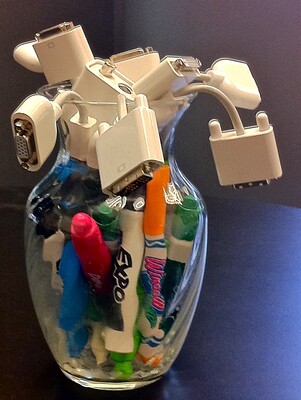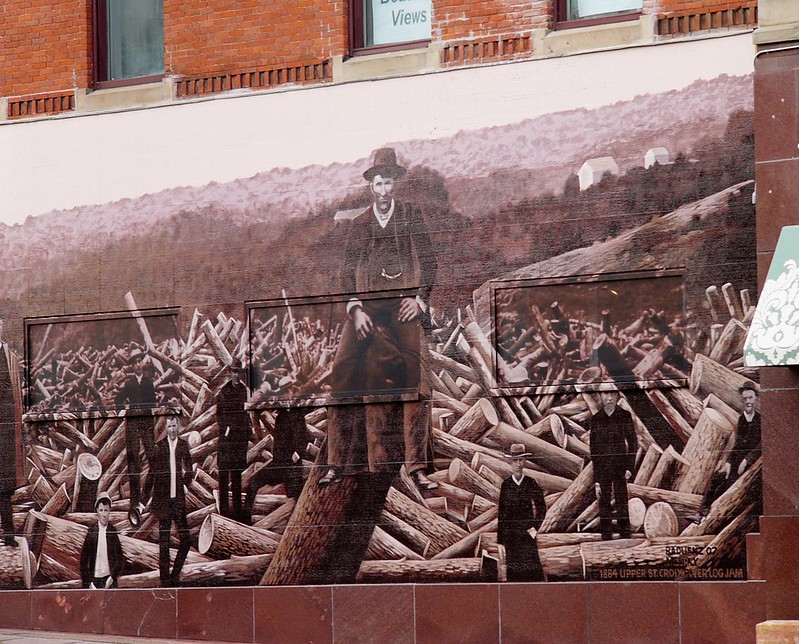Posts Tagged ‘Problems’
Why is it so difficult to get ready?
 The time to start getting ready is before we need to be.
The time to start getting ready is before we need to be.
We don’t get ready because the problem hasn’t yet kicked us in the head. It has only started getting ready to do so.
We don’t get ready because we don’t see the early warning signs. Like the meteorologist who doesn’t make time to look at the radar and satellite images, if we don’t look, we can’t see. And if we’re really busy, we don’t make time to look. What if it was part of our job to look at the satellite images? Who in our company should have that job?
We don’t get ready because we don’t heed the early warning signs. Seeing the warning signs is much different than justifying the reallocation of resources because someone says the tea leaves suggest an impending problem.
We will solve no problem until it’s too late to do anything else.
We don’t get ready because we forget that it takes time to get ready. We do so little getting ready, we’re unfamiliar with the work content and timeline of getting ready. We forget that getting ready is on the critical path of problem-solving.
We don’t get ready because everyone is fully booked and we have no excess capacity to allocate to getting ready. And by the time we free up the resources to get ready (if we can do that at all), we miss the window of opportunity to get ready.
We will solve a problem only after exhausting all other possibilities.
We don’t get ready because the problem is someone else’s. If we don’t have capacity to get ourselves ready for our problems why would we allocate the capacity to get ready for someone else’s?
We don’t get ready because we try to give our problem to someone else. Isn’t it easier to convince someone else to get ready than to do the getting ready ourselves?
We will solve no problem until we know we’ll get the credit.
We don’t get ready because problem avoidance won’t get us promoted, though putting out a fire that could have been avoided will.
If a problem is avoided, there is no problem. And since there’s no problem, there’s no need to avoid it.
We don’t get ready because there’s no certainty a problem will be a problem until we have it. And we can’t get ready to solve a problem once we have it. Getting ready requires judgment and trust – judgment by the person who sees the early warning signs and trust by the person who allocates the resources. It’s that simple.
Because we’ve conditioned people to be afraid to use their judgment, they don’t use it. And because we’ve conditioned people to be afraid to spend the time needed to build trust, they don’t build it.
Now that we have these two problems, how can we make it safe for people to use their judgment and spend the time needed to develop trust?
Image credit — Leonard J Matthews
There is nothing wrong with having problems.
 When you are stuck, often the problems you can describe are not the problems that are in the way.
When you are stuck, often the problems you can describe are not the problems that are in the way.
The problems you solved last time make it more difficult to see new problems this time.
The problems you know of are not the problem.
When you have no problems, you have big problems.
When you have no problem, there is no way to justify additional resources.
When you have no problem, you better finish on time.
When you’re stuck on a problem, make it worse and solve it by doing the opposite.
Problems are not bad, even though bringing them to everyone’s attention may be bad for your career.
And if talking about problems is bad for your career, you are working at the wrong company.
Until you can explain the problem in plain language, you do not understand it.
And when you do not understand a problem, you can’t solve it.
Solutions start with a problem.
Two questions to ask: Where is the problem and when does it occur?
Problems are solved with microscopes and not telescopes. Get close to the problem.
Your problem is not new. Someone has solved it in a different application, context, or product.
There are at least three ways to solve a problem: before it occurs, while it occurs, or after it occurs,
Sometimes solving a difficult problem requires the generation of an easily solvable problem. So be it.
Problems are more powerful than opportunities. Call them by their name.
Because without problems, there can be no solutions.
Image credit – Andy Morffew
When there are teaching moments, what do you teach?
 When you have something special but don’t know it, the Universe is there to take it away from you so you can appreciate what you no longer have. Seems backward, but the Universe knows how to be a good teacher.
When you have something special but don’t know it, the Universe is there to take it away from you so you can appreciate what you no longer have. Seems backward, but the Universe knows how to be a good teacher.
When someone asks you to help them, but you know they are asking for the wrong thing, what do you do? Do you feel pressure to maintain a good working relationship? Do you suggest something different? Or do you simply decline to help? What would the Universe do? It would probably play the long game.
When a team does not follow good practice even though they have the tools, talent, and time, and then asks you to do that very work, what do you do? Do you do the work they should have done? Do you suggest they allocate their resources to the problem? Do you ask them why they didn’t do the right work in the first place? What would the Universe do? Would do a little bit of everything. What would it want that team to learn?
When there’s disagreement on the approach, there can be no agreement on lower-level elements of the work. What do you do? Flip a coin? Arm wrestle? Yell at each other? I think the Universe would want to understand the design space in the most effective way, and I think it would try all the coherent approaches in a small way and see what happens. Then, it would ask everyone to get back together to review the results and decide what to do next.
There are teaching moments every day. But it’s never clear what to teach. Does the urgency and significance of the moment mean that the immediate problem should be solved and the teaching should wait until the next time? Is the teaching that the higher-level systemic problem is so significant that the short-term pain must be experienced to create momentum around solving the systemic problem? Is the teaching that the team should be given help in a way that preserves their emotional well-being so they can finish the project in good spirits and help them elevate their work next time?
With teaching moments there are no right answers. Sometimes you take the opportunity to teach and sometimes you look the other way. Sometimes you hold people accountable and sometimes you soothe egos. Sometimes you withhold resources and sometimes you jump in with both feet.
And like the Universe, you get better at teaching the more you do it.
Image credit — Andrew Kuznetsov
Projects, Problems and People
 The projects you choose define the problems you solve.
The projects you choose define the problems you solve.
The problems you choose to solve define the novel value delivered to the customer.
The people you choose to run the projects set the character of the projects.
The choice of the projects’ character defines how the people feel about working on the projects.
How people choose to feel about working on the projects influences the character of the projects.
The people on the projects choose how the problems are solved.
How people choose to solve problems defines how well the problems are solved.
The choice around how well problems are solved sets the level of goodness delivered to the customer.
The level of goodness you choose to deliver to the customer governs the incremental revenue you create.
It doesn’t seem right that the amount of incremental revenue is a choice.
But, when you choose the right projects and the right people to run them and you choose the right problems and the right people to solve them, incremental revenue becomes your choice.
image credit — officallychaz
Which new product development project should we do first?
 X: Of the pool of candidate new product development projects, which project should we do first?
X: Of the pool of candidate new product development projects, which project should we do first?
Me: Let’s do the one that makes us the most money.
X: Which project will make the most money?
Me: The one where the most customers buy the new product, pay a reasonable price, and feel good doing it.
X: And which one is that?
Me: The one that solves the most significant problem.
X: Oh, I know our company’s most significant problem. Let’s solve that one.
Me: No. Customers don’t care about our problems, they only care about their problems.
X: So, you’re saying we should solve the customers’ problem?
Me: Yes.
X: Are you sure?
Me: Yes.
X: We haven’t done that in the past. Why should we do it now?
Me: Have your previous projects generated revenue that met your expectations?
X: No, they’ve delivered less than we hoped.
Me: Well, that’s because there’s no place for hope in this game.
X: What do you mean?
Me: You can’t hope they’ll buy it. You need to know the customers’ problems and solve them.
X: Are you always like this?
Me: Only when it comes to customers and their problems.
image credit: Kyle Pearce
The Power of Leaving a Problem Unsolved
 Nothing changes unless there’s a problem.
Nothing changes unless there’s a problem.
In fact, without a problem, there can be no solution.
One of the devious ways to solve your problem is to create conditions for others to think it’s their problem.
Shame on you if you try to get me to solve your problem.
And shame on me if I try to solve your problem.
The best way for the problem to find its rightful owner is to leave the problem unsolved.
But leaving the problem unsolved also increases the pressure on all the innocent non-owners that work near the problem.
Leaving the problem unsolved is like a game of chicken, where the person who flinches first loses.
No one can give you their problem without your consent, but that doesn’t mean they won’t try.
So, when someone tries to give you their problem, put your hands in your pockets.
Leaving the problem unsolved isn’t a sign of non-caring, it’s a sign of higher-level caring.
Leaving the problem unsolved is the only way to pressure the company into the higher-level (and unpleasant) organizational learning of who is not solving their own problems.
“Prepare for Squirting” by Wootang01 is licensed under CC BY-ND 2.0.
Problems, Learning, Business Models, and People
 If you know the right answer, you’re working on an old problem or you’re misapplying your experience.
If you know the right answer, you’re working on an old problem or you’re misapplying your experience.
If you are 100% sure how things will turn out, let someone else do it.
If there’s no uncertainty, there can be no learning.
If there’s no learning, your upstart competitors are gaining on you.
If you don’t know what to do, you’ve started the learning cycle.
If you add energy to your business model and it delivers less output, it’s time for a new business model.
If you wait until you’re sure you need a new business model, you waited too long.
Successful business models outlast their usefulness because they’ve been so profitable.
When there’s a project with a 95% chance to increase sales by 3%, there’s no place for a project with a 50% chance to increase sales by 100%.
When progress has slowed, maybe the informal networks have decided slower is faster.
If there’s something in the way, but you cannot figure out what it is, it might be you.
“A bouquet of wilting adapters” by rexhammock is licensed under CC BY-SA 2.0.
Is it time to break the logjam?
Clearing a logjam is not about increasing the force of the water. It’s about moving one log out of the way, watching what happens, and choosing the next log to move.
Crossing a raging river is not about pushing against the current. It’s about seeing what’s missing and using logs to build a raft.
Trekking across the tundra after crossing the raging river is not about holding onto the logs that helped you cross. It’s about seeing what’s not needed and leaving the raft by the river.
The trick is to know when to move the logs, when to use them to build a raft, and when to leave them behind.
Image credit: “Log Jam Mural _ Stillwater MN” by Kathleen Tyler Conklin is licensed under CC BY 2.0.
Testing is an important part of designing.
 When you design something, you create a solution to a collection of problems. But it goes far beyond creating the solution. You also must create objective evidence that demonstrates that the solution does, in fact, solve the problems. And the reason to generate this evidence is to help the organization believe that the solution solves the problem, which is an additional requirement that comes with designing something. Without this belief, the organization won’t go out to the customer base and convince them that the solution will solve their problems. If the sales team doesn’t believe, the customers won’t believe.
When you design something, you create a solution to a collection of problems. But it goes far beyond creating the solution. You also must create objective evidence that demonstrates that the solution does, in fact, solve the problems. And the reason to generate this evidence is to help the organization believe that the solution solves the problem, which is an additional requirement that comes with designing something. Without this belief, the organization won’t go out to the customer base and convince them that the solution will solve their problems. If the sales team doesn’t believe, the customers won’t believe.
In school, we are taught to create the solution, and that’s it. Here are the drawings, here are the materials to make it, here is the process documentation to build it, and my work here is done. But that’s not enough.
Before designing the solution, you’ve got to design the tests that create objective evidence that the solution actually works, that it provides the right goodness and it solves the right problems. This is an easy thing to say, but for a number of reasons, it’s difficult to do. To start, before you can design the right tests, you’ve got to decide on the right problems and the right goodness. And if there’s disagreement and the wrong tests are defined, the design community will work in the wrong areas to generate the wrong value. Yes, there will be objective evidence, and, yes, the evidence will create a belief within the organization that problems are solved and goodness is achieved. But when the sales team takes it to the customer, the value proposition won’t resonate and it won’t sell.
Some questions to ask about testing. When you create improvements to an existing product, what is the family of tests you use to characterize the incremental goodness? And a tougher question: When you develop a new offering that provides new lines of goodness and solves new problems, how do you define the right tests? And a tougher question: When there’s disagreement about which tests are the most important, how do you converge on the right tests?
Image credit — rjacklin1975
Problems, Solutions, and Complaints
 If you see a problem, tell someone. But, also, tell them how you’d like to improve things.
If you see a problem, tell someone. But, also, tell them how you’d like to improve things.
Once you see a problem, you have an obligation to seek a solution.
Complaining is telling someone they have a problem but stopping short of offering solutions.
To stop someone from complaining, ask them how they might make the situation better.
Problems are good when people use them as a forcing function to create new offerings.
Problems are bad when people articulate them and then go home early.
Thing is, problems aren’t good or bad. It’s our response that determines their flavor.
If it’s your problem, it can never be our solution.
Sometimes the best solution to a problem is to solve a different one.
Problem-solving is 90% problem definition and 10% getting ready to define the problem.
When people don’t look critically at the situation, there are no problems. And that’s a big problem.
Big problems require big solutions. And that’s why it’s skillful to convert big ones into smaller ones.
Solving the right problem is much more important than solving the biggest problem.
If the team thinks it’s impossible to solve the problem, redefine the problem and solve that one.
You can relabel problems as “opportunities” as long as you remember they’re still problems
When it comes to problem-solving, there is no partial credit. A problem is either solved or it isn’t.
Stop reusing old ideas and start solving new problems.
 Creating new ideas is easy. Sit down, quiet your mind, and create a list of five new ideas. There. You’ve done it. Five new ideas. It didn’t take you a long time to create them. But ideas are cheap.
Creating new ideas is easy. Sit down, quiet your mind, and create a list of five new ideas. There. You’ve done it. Five new ideas. It didn’t take you a long time to create them. But ideas are cheap.
Converting ideas into sellable products and selling them is difficult and expensive. A customer wants to buy the new product when the underlying idea that powers the new product solves an important problem for them. In that way, ideas whose solutions don’t solve important problems aren’t good ideas. And in order to convert a good idea into a winning product, dirt, rocks, and sticks (natural resources) must be converted into parts and those parts must be assembled into products. That is expensive and time-consuming and requires a factory, tools, and people that know how to make things. And then the people that know how to sell things must apply their trade. This, too, adds to the difficulty and expense of converting ideas into winning products.
The only thing more expensive than converting new ideas into winning products is reusing your tired, old ideas until your offerings run out of sizzle. While you extend and defend, your competitors convert new ideas into new value propositions that bring shame to your offering and your brand. (To be clear, most extend-and-defend programs are actually defend-and-defend programs.) And while you reuse/leverage your long-in-the-tooth ideas, start-ups create whole new technologies from scratch (new ideas on a grand scale) and pull the rug out from under you. The trouble is that the ultra-high cost of extend-and-defend is invisible in the short term. In fact, when coupled with reuse, it’s highly profitable in the moment. It takes years for the wheels to fall off the extend-and-defend bus, but make no mistake, the wheels fall off.
When you find the urge to create a laundry list of new ideas, don’t. Instead, solve new problems for your customers. And when you feel the immense pressure to extend and defend, don’t. Instead, solve new problems for your customers.
And when all that gets old, repeat as needed.
“Cave paintings” by allspice1 is licensed under CC BY-ND 2.0

 Mike Shipulski
Mike Shipulski